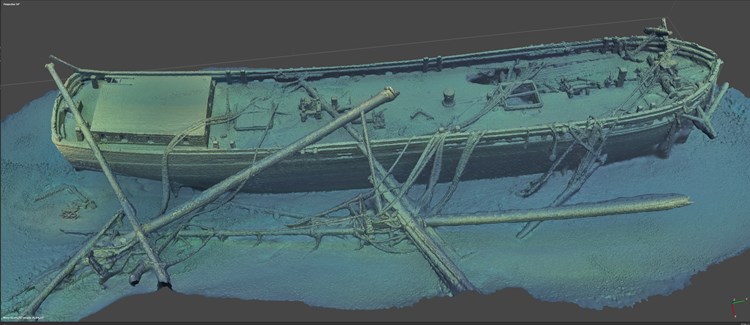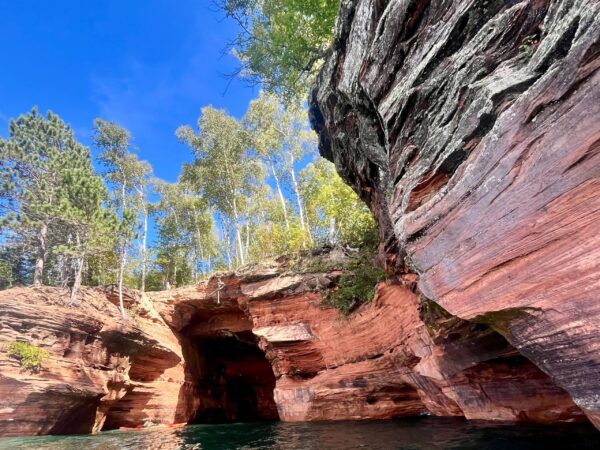
A 150-year-old schooner that sank in 1881, was finally discovered in Lake Michigan.
On July 15, maritime historians, Brendon Baillod and Bob Jaeck located the old shipwreck off the coast of Algoma, Wisconsin. The Trinidad was on their radar for more than twenty years, as the ship was a strong candidate for research; the captain and his eight crew members all survived (except their trusted Newfoundland), providing a good description of where the vessel sank.
After eight hours of struggling to row ashore, Captain Higgins told marine reporters that he thought it all started in the Straits of Mackinac, where the hull was likely cut by ice. According to insurance records, Baillod reports that the ship did not receive the normal standard of maintenance, as most ships in this era lasted twice as long with regular recaulking or replacing decayed or rotted parts.
The Trinidad was built in 1867, in Grand Island, New York to bring coal to cities along the western part of the Great Lakes. On its way back, the vessel would carry “prairie gold” or wheat back to cities on the east coast. Finding coal was one of the ways Baillod and Jaeck were able to verify it as the Trinidad.
“Shipwrecks on the Great Lakes, was a reality of the industry,” said Baillod. “It was very dangerous on any given voyage, unless it was in high-summer, you could count on having some peril.”
Baillod said the boat’s Captain, John Higgins, would go on to retire shortly after the Trinidad sank. He had been in a number of other shipwrecks, including one that occurred off the coast of Racine, Wisconsin, a few years earlier in 1877. He said, the Trinidad’s crew were loath to publicly impugn the condition of their schooner, because it would be hard to sail again or get another shipowner to trust them if they were seen disparaging their former vessel.
“There was no cry from the public,” said Baillod. “You could also die working in a foundry just as easily or in many other vocations at that time in the 1870s or 80s.”
He went on to explain how coal needed to be delivered for winter heating. It was also when the grain cargo and many other crops would come in and need to be delivered. It was the time when the weather was the worst and the most unpredictable. How those mariners had no weather radar, with no modern waterproof weather gear. He said, the chances of getting into trouble were excellent, which was why people died by the thousands on the Great Lakes every year.
Growing up on Lake Superior, Baillod had shipwrecks right off his house on the Keweenaw Waterway—he’s been doing this work his whole life. He started snorkeling and cleaning the lures off sunken ships at an early age. He got to wondering, what are these ships? No one knew their names, so as a teenager he started researching them in local newspapers, only to discover they were some of the most historic schooners on Lake Superior. By the time he was in his twenties, the Keweenaw Underwater Preserve was founded, thanks to the Abandoned Shipwreck Act (1987), that meant each state was entitled to the known shipwrecks in their waters. Now, Baillod works privately to locate some of the unknown vessels.
It took Baillod and his business partner about two years to locate the Trinidad. They constructed a search grid, to help narrow down the amount of time out on the water, because wrecks cannot be looked for with side-scan sonar if there are any kind of waves, and they also needed good thermocline conditions. Their first day out searching, they didn’t see any of the bottom, it was completely bare and undifferentiated, which is unusual. Most parts of the lake have some geology or some ripples or something, said Baillod.
The second day, second pass, they were getting into the middle of the grid, when they ran over an unusual little indistinct smudge. They both agreed that they should turn around and look. So, they turned the boat around, slowed down and pulled in the range to about 600 feet, when they almost burned a hole on the screen—as they went over what was very clearly a vessel hull
“We were so excited that we pulled out our cell phones, we started recording it live,” said Baillod. “Live imagery at the moment of discovery. We both were pretty excited. I mean, it wasn’t the first shipwreck we ever found, but we were pretty excited.”
The maritime archeology program in Wisconsin, is very engaged, according to Baillod. Which was why only two weeks after the discovery, he and his business partner were able to access extra equipment to further survey the wreck and verify it was in fact the Trinidad. Baillod said, their next plans are to nominate the remains to the National Register of Historic Places. Once the Trinidad has been documented and is on the National Register, the ship’s location will be made public. This way, technical divers can visit the remains of one of the top three most preserved wrecks in Wisconsin, without worrying about anyone harming the artifact.
As for what’s next, Baillod said there is a clock ticking on locating other vessels. With the quagga mussels, they are carpeting wrecks in the Great Lakes, and putting a lot of weight on them. He said, 20 or 30-years-ago the Trinidad would have looked like a ship in a bottle. Due to this invasive species, now ships are deteriorating faster, essentially covered in what look like warts. As for what ships they’re trying to locate next, people can check their website shipwreckworld.com for updates, otherwise he and Jaeck are keeping these next searches close to their chest.
Catch more news at Great Lakes Now:
Researchers: Current Great Lakes stewardship is “ill-equipped” to handle future challenges
Great Lakes Moment: University of Windsor to build capacity for Canada’s national urban parks
Featured image: Schooner Trinidad as she appears today (Photo Credit: Tamara Thomsen & Zach Whitrock, State Historical Society of Wisconsin)




